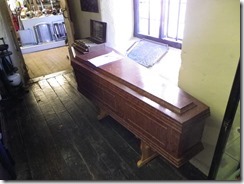
 Bakelite
Bakelite
Bakelite was the forerunner of the modern plastics industry. Used in all manner of electrical devices, household objects, appliances and decorative items. Bakelite holds a true position in nostalgic history.
![]()
Bakelite also known as polyoxybenzylmethylenglycolanhydride is a thermosetting phenol formaldehyde resin. It was first developed by Belgium born chemist Leo Baekeland in New York in 1907. It’s electrical nonconductive, heat resistant and mouldable properties placed it in great demand in electrical insulators, radio and telephone casings, kitchenware, pipe stems, jewellery, children’s toys and many other diverse products.
A visit to the Bakelite Museum at Orchard Mill, Williton, Somerset TA44NS is well worth the time whether on holiday or visiting the area. Set in a Grade II list mill, the museum is run by Patrick Cook and displays his vast treasure trove of of items made wholly or partly from Bakelite.
![]()
Many early radios were made with wood casings but with the advent of Bakelite, the switch to moulded casings was rapid. The flexibility of the new material also allowed designers to create what was then considered futuristic designs.
Large or small, Bakelite was completely adaptable for every situation. One disadvantage of Bakelite is it tended to be more brittle than modern plastics. This led to accidently dislodged radio casings cracking or completely shattering when they hit the floor. It was not an uncommon sight in homes to see broken radio casings held together by string, glue, sticking plasters or a variety of sticky tape.
![]()
Trumpet speakers for early wirelesses were a follow-on from early gramophones or phonographs. Early radio reception was quite rudimentary and sound volume controls, (amplification), was not invented until 1925.
An example of a futuristic designed wireless set. Although wireless sets received radio transmissions, the term “radio-set” did not come into popular usage until the latter half of the 20th century. By definition a wireless set had no wires and early sets were frequently powered by heavy rechargeable accumulator type batteries.
![]()
Early steam irons heated on a gas ring. Water in a small reservoir pressurised by a built in hand pump dripped the water onto the hot plate to produce steam. Due to its low heat conductivity, moulded Bakelite formed the handle.
Early electrical steam irons. Electricity heated the base-plate and water in a small reservoir pressurised by a built in hand pump dripped onto the hot plate to produce steam. At this time due the low heat conductivity, Bakelite handles retained their popularity.
![]()
Originally almost dark brown in colour, the development of lighter colours and patterning made for more attractive kitchenware as can be seen in these jelly moulds and fruit juice squeezers. Bakelite also had the great advantage over its metal predecessors in that it did not rust and was easy to clean.
The introduction of coloured Bakelite also led to a large range of tableware being produced. Cruet sets, egg cups, toast racks, napkin holders, mustard pots and butter dishes were among the vast paraphernalia of multi-coloured moulded tableware.
![]()
With the blossoming domestic electricity market in the mid 20th century, the non-conductive property of Bakelite made it the ideal material for forming a large range of electrical products including insulators, plugs and sockets, meters and junction boxes. Due to both the cost and inconvenience caused by lifting floorboards and chasing cable runs in walls, in early domestic electrical installations it was the practice to fit only one power socket and light in each room.
The initial lack of power outlets led to the development of light adaptors designed to run an additional electrical appliance from the light cord. Due to a general lack of understanding of electrical power loadings, it was not uncommon for people to join together numerous light adaptors in a Christmas Tree style. This led to many house fires as power cables overheated the early types which were only insulated by cloth, rubber or paper.
![]()
![]()
…. while other components were fitted to a dentists drilling machine, the sight of which may bring back memories of horror.
![]()
![]()
![]()
![]()
![]()
![]()
![]()
![]()
![]()
![]()
Up and coming Edwardian business gentlemen would be sure to have the latest equipment in their office or study. This is an early example of a Dictaphone housed in a Bakelite casing. It worked on the same principle as early record players. A needle etched grooves from sound vibrations onto a wax cylinder which a secretary would later play back and listen to.
Even at life’s end Bakelite was there to accompany a person on their final journey with this example of an unusual, if not quirky, rot-proof Bakelite coffin. Probably not quite what those today desiring a “Green Funeral” have in mind.
![]()
Although Bakelite has rapidly faded from memory and is rarely mentioned in history, it did have a profound effect on shaping modern day lifestyles in a multitude of ways. I trust this page in some way pays homage to what was at one time, the wonder material of the century.



































Mick thanks for sending about “Bakelite” now I know that almost every gadgets I got is made of the above and everytime I used it I will remember.::))
…come and see BakeliteMuseumArlesheim:)